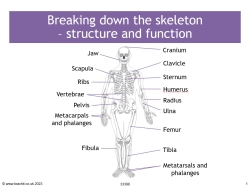Breaking down the skeleton – structure and function

An engaging key stage 3 biology resource that really gets students thinking about the structure and function of the main bones in the human skeleton.
Students start by explaining how the shape of each bone in the skeletal system relates to its function. There is a scaffolded version where they can circle the part of the body where each bone is found.
Students then sort the bones into categories and sequence them from most important to least important using a diamond ranking template. They are asked to justify their choices.
A labelled diagram of the key bones in the human body is provided.
There are extension questions about the everyday equivalents for some of the Latin names and about the less obvious functions of the skeletal system, such as the protection of internal organs, and the production of blood cells in bone marrow.
The bones covered in this resource are:
- cranium
- femur
- pelvis
- vertebrae
- scapula
- radius
- sternum
- tibia
- ulna
- metatarsals and phalanges
- jaw
- fibula
- metacarpals and phalanges
- ribs
- humerus
- clavicle.
You might also like the free online Human Skeleton Quiz on our sister site Infoplease.
An extract from the answers to the extension questions:
Patella = kneecap, clavicle = collarbone, scapula = shoulder blade, sternum = breastbone.
Protect vital organs: skull, rib cage, vertebrae in the spine.
Involved with movement: humerus, jaw and metatarsals, for example.
